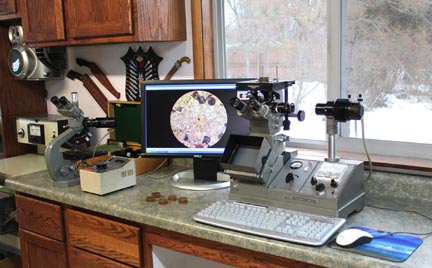





The Matherton Forge Metallurgical Research and Development
Lab
 A remodel of a section of my shop included ample lighting, I also incorporated plenty of cabinet space and plumbed in a water supply so that it has everything “including” a kitchen sink. This has made my life much more pleasant for mixing solutions and doing the etching work for my damascus and test sample preparation.
A remodel of a section of my shop included ample lighting, I also incorporated plenty of cabinet space and plumbed in a water supply so that it has everything “including” a kitchen sink. This has made my life much more pleasant for mixing solutions and doing the etching work for my damascus and test sample preparation.


 My obsessive/compulsive nature toward the metllurgy of my blades made the ability to look inside the steel a necessity. Martensite is hard and will skate a file, but the same is true of a poor mix of fine pearlite, and the Hardness tester can’t tell you the grain size that is just as important for performance. To meet these needs I have acquired several Olympus metallurgical microscopes over time.
Each has its own capabilities that I desire. One has a wide and completely adjustable stage for laying an entire blade on for examination, while the other has a very tightly controlled stage that can handle slide mounted specimens, and trans-illumination. One is binocular for regular viewing, but has brightfield and darkfield capabilities, the other is trinocular to handle the mounting of my digital camera for easy metallographic uses. The one I use the most is the large and veristile Olympus PME metallograph designed specifically for metallograpy. Metallography, or photography of the microstructure inside steel is accomplished on my PME using adpaters to mount a Cannon T2I digital SLR to the metallograph in place of the film camera it initially used. This allows the process to be ran thourgh a computer and I can work of a 20" high resolution LCD monitor. With compatible software, I can control the camera from the computer and view my images on the wide screen. This is networked to my other computers in the house and the internet so that I can almost instantly produce and upload images to the web.
My obsessive/compulsive nature toward the metllurgy of my blades made the ability to look inside the steel a necessity. Martensite is hard and will skate a file, but the same is true of a poor mix of fine pearlite, and the Hardness tester can’t tell you the grain size that is just as important for performance. To meet these needs I have acquired several Olympus metallurgical microscopes over time.
Each has its own capabilities that I desire. One has a wide and completely adjustable stage for laying an entire blade on for examination, while the other has a very tightly controlled stage that can handle slide mounted specimens, and trans-illumination. One is binocular for regular viewing, but has brightfield and darkfield capabilities, the other is trinocular to handle the mounting of my digital camera for easy metallographic uses. The one I use the most is the large and veristile Olympus PME metallograph designed specifically for metallograpy. Metallography, or photography of the microstructure inside steel is accomplished on my PME using adpaters to mount a Cannon T2I digital SLR to the metallograph in place of the film camera it initially used. This allows the process to be ran thourgh a computer and I can work of a 20" high resolution LCD monitor. With compatible software, I can control the camera from the computer and view my images on the wide screen. This is networked to my other computers in the house and the internet so that I can almost instantly produce and upload images to the web.All images and text Copyrighted © 2006 Kevin R. Cashen, www.cashenblades.com